towing INFINITI QX50 2021 User Guide
[x] Cancel search | Manufacturer: INFINITI, Model Year: 2021, Model line: QX50, Model: INFINITI QX50 2021Pages: 542, PDF Size: 3.51 MB
Page 302 of 542
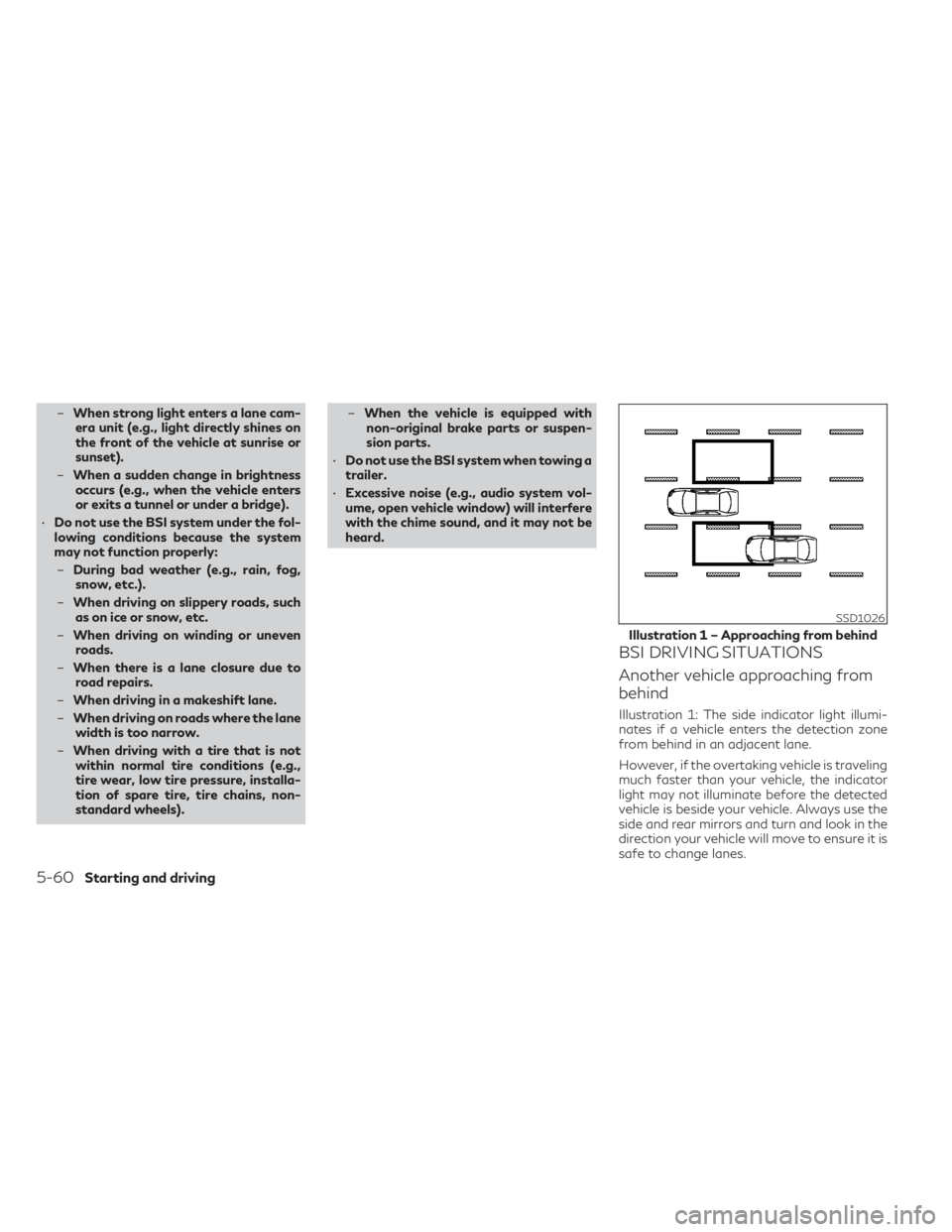
–When strong light enters a lane cam-
era unit (e.g., light directly shines on
the front of the vehicle at sunrise or
sunset).
– When a sudden change in brightness
occurs (e.g., when the vehicle enters
or exits a tunnel or under a bridge).
• Do not use the BSI system under the fol-
lowing conditions because the system
may not function properly:
– During bad weather (e.g., rain, fog,
snow, etc.).
– When driving on slippery roads, such
as on ice or snow, etc.
– When driving on winding or uneven
roads.
– When there is a lane closure due to
road repairs.
– When driving in a makeshift lane.
– When driving on roads where the lane
width is too narrow.
– When driving with a tire that is not
within normal tire conditions (e.g.,
tire wear, low tire pressure, installa-
tion of spare tire, tire chains, non-
standard wheels). –
When the vehicle is equipped with
non-original brake parts or suspen-
sion parts.
• Do not use the BSI system when towing a
trailer.
• Excessive noise (e.g., audio system vol-
ume, open vehicle window) will interfere
with the chime sound, and it may not be
heard.
BSI DRIVING SITUATIONS
Another vehicle approaching from
behind
Illustration 1: The side indicator light illumi-
nates if a vehicle enters the detection zone
from behind in an adjacent lane.
However, if the overtaking vehicle is traveling
much faster than your vehicle, the indicator
light may not illuminate before the detected
vehicle is beside your vehicle. Always use the
side and rear mirrors and turn and look in the
direction your vehicle will move to ensure it is
safe to change lanes.
SSD1026
Illustration 1 – Approaching from behind
5-60Starting and driving
Page 335 of 542

–When traffic conditions make it diffi-
cult to keep a proper distance be-
tween vehicles because of frequent
acceleration or deceleration
– Interference by other radar sources.
• Do not use the ICC system if you are
towing a trailer. The system may not de-
tect a vehicle ahead.
• In some road or traffic conditions, a ve-
hicle or object can unexpectedly come
into the sensor detection zone and cause
automatic braking. Always stay alert
and avoid using the ICC system where
not recommended in this warning
section.
The ICC system will not detect the following
objects:
• Stationary or slow moving vehicles
• Pedestrians or objects in the roadway
• Oncoming vehicles in the same lane
• Motorcycles traveling offset in the travel lane
The following are some conditions in which
the radar sensor cannot properly detect a
vehicle ahead and the system may not oper-
ate properly: • When the sensor detection is reduced (con-
ditions such as rain, snow, fog, dust storms,
sandstorms, and road spray from other
vehicles)
• Driving on a steep downhill slope or roads with sharp curves
• Driving on a bumpy road surface, such as an uneven dirt road
• If dirt, ice, snow or other material is cover- ing the radar sensor area
• A complicated-shaped vehicle such as a car carrier trailer or flatbed truck/trailer is near
the vehicle ahead.
• Interference by other radar sources
• When your vehicle is towing a trailer, etc.
• When excessively heavy baggage is loaded in the rear seat or cargo area of your
vehicle.
The ICC system is designed to automatically
check the radar sensor’s operation within the
limitations of the system.
The detection zone of the radar sensor is
limited. A vehicle ahead must be in the detec-
tion zone for the ICC system to maintain the
selected distance from the vehicle ahead. A
vehicle ahead may move outside of the de-
tection zone due to its position within the
same lane of travel. Motorcycles may not be
detected in the same lane ahead if they are traveling offset from the center line of the
lane. A vehicle that is entering the lane ahead
may not be detected until the vehicle has
completely moved into the lane.
If this occurs, the ICC system may warn you
by blinking the system indicator and sounding
the chime. The driver may have to manually
control the proper distance away from the
vehicle traveling ahead.
The ICC system (with ProPILOT Assist) uses
a multi-sensing front camera. The following
are some conditions in which the camera may
not properly detect a vehicle and detection of
a vehicle ahead may be delayed:
• Poor visibility (conditions such as rain,
snow, fog, dust storms, sandstorms, and
road spray from other vehicles)
• The camera area of the windshield is fogged up or covered with dirt, water
drops, ice, snow, etc.
• Strong light (for example, sunlight or high beams from oncoming vehicles) enters the
front camera
• A sudden change in brightness occurs (for example, when the vehicle enters or exits a
tunnel or shaded area or lightning flashes)
Starting and driving5-93
Page 343 of 542
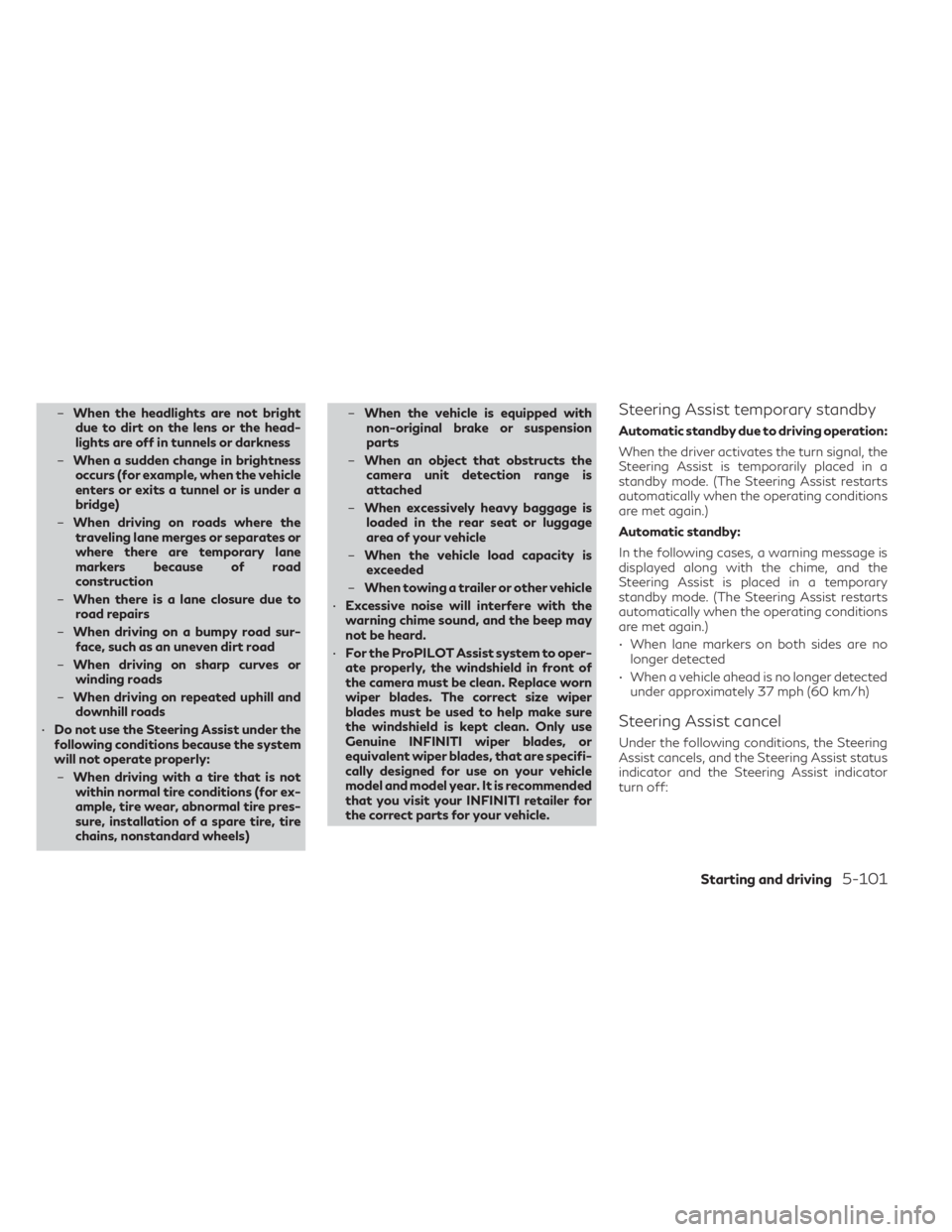
–When the headlights are not bright
due to dirt on the lens or the head-
lights are off in tunnels or darkness
– When a sudden change in brightness
occurs (for example, when the vehicle
enters or exits a tunnel or is under a
bridge)
– When driving on roads where the
traveling lane merges or separates or
where there are temporary lane
markers because of road
construction
– When there is a lane closure due to
road repairs
– When driving on a bumpy road sur-
face, such as an uneven dirt road
– When driving on sharp curves or
winding roads
– When driving on repeated uphill and
downhill roads
• Do not use the Steering Assist under the
following conditions because the system
will not operate properly:
– When driving with a tire that is not
within normal tire conditions (for ex-
ample, tire wear, abnormal tire pres-
sure, installation of a spare tire, tire
chains, nonstandard wheels) –
When the vehicle is equipped with
non-original brake or suspension
parts
– When an object that obstructs the
camera unit detection range is
attached
– When excessively heavy baggage is
loaded in the rear seat or luggage
area of your vehicle
– When the vehicle load capacity is
exceeded
– When towing a trailer or other vehicle
• Excessive noise will interfere with the
warning chime sound, and the beep may
not be heard.
• For the ProPILOT Assist system to oper-
ate properly, the windshield in front of
the camera must be clean. Replace worn
wiper blades. The correct size wiper
blades must be used to help make sure
the windshield is kept clean. Only use
Genuine INFINITI wiper blades, or
equivalent wiper blades, that are specifi-
cally designed for use on your vehicle
model and model year. It is recommended
that you visit your INFINITI retailer for
the correct parts for your vehicle.Steering Assist temporary standby
Automatic standby due to driving operation:
When the driver activates the turn signal, the
Steering Assist is temporarily placed in a
standby mode. (The Steering Assist restarts
automatically when the operating conditions
are met again.)
Automatic standby:
In the following cases, a warning message is
displayed along with the chime, and the
Steering Assist is placed in a temporary
standby mode. (The Steering Assist restarts
automatically when the operating conditions
are met again.)
• When lane markers on both sides are no longer detected
• When a vehicle ahead is no longer detected under approximately 37 mph (60 km/h)
Steering Assist cancel
Under the following conditions, the Steering
Assist cancels, and the Steering Assist status
indicator and the Steering Assist indicator
turn off:
Starting and driving5-101
Page 355 of 542
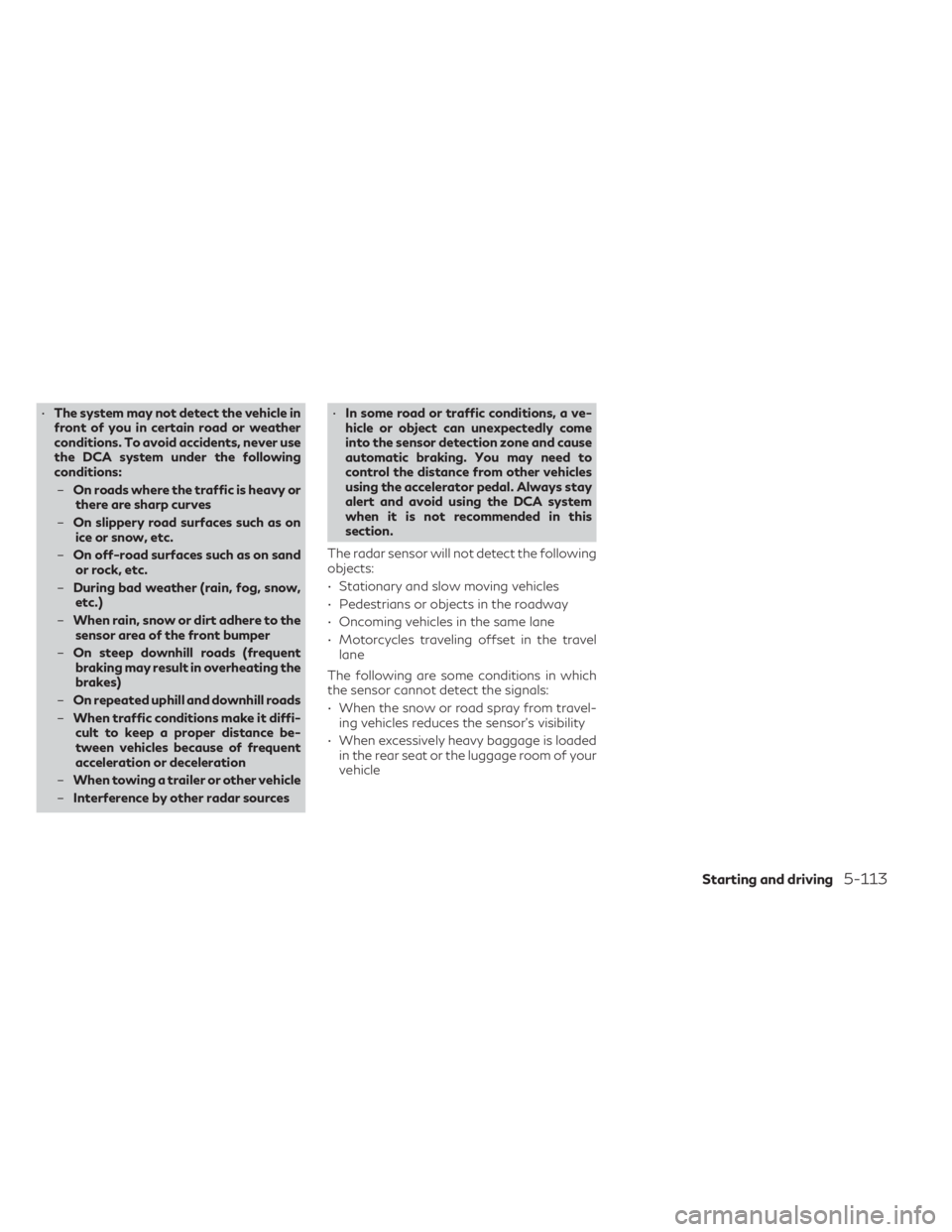
•The system may not detect the vehicle in
front of you in certain road or weather
conditions. To avoid accidents, never use
the DCA system under the following
conditions:
– On roads where the traffic is heavy or
there are sharp curves
– On slippery road surfaces such as on
ice or snow, etc.
– On off-road surfaces such as on sand
or rock, etc.
– During bad weather (rain, fog, snow,
etc.)
– When rain, snow or dirt adhere to the
sensor area of the front bumper
– On steep downhill roads (frequent
braking may result in overheating the
brakes)
– On repeated uphill and downhill roads
– When traffic conditions make it diffi-
cult to keep a proper distance be-
tween vehicles because of frequent
acceleration or deceleration
– When towing a trailer or other vehicle
– Interference by other radar sources •
In some road or traffic conditions, a ve-
hicle or object can unexpectedly come
into the sensor detection zone and cause
automatic braking. You may need to
control the distance from other vehicles
using the accelerator pedal. Always stay
alert and avoid using the DCA system
when it is not recommended in this
section.
The radar sensor will not detect the following
objects:
• Stationary and slow moving vehicles
• Pedestrians or objects in the roadway
• Oncoming vehicles in the same lane
• Motorcycles traveling offset in the travel lane
The following are some conditions in which
the sensor cannot detect the signals:
• When the snow or road spray from travel- ing vehicles reduces the sensor’s visibility
• When excessively heavy baggage is loaded in the rear seat or the luggage room of your
vehicle
Starting and driving5-113
Page 364 of 542
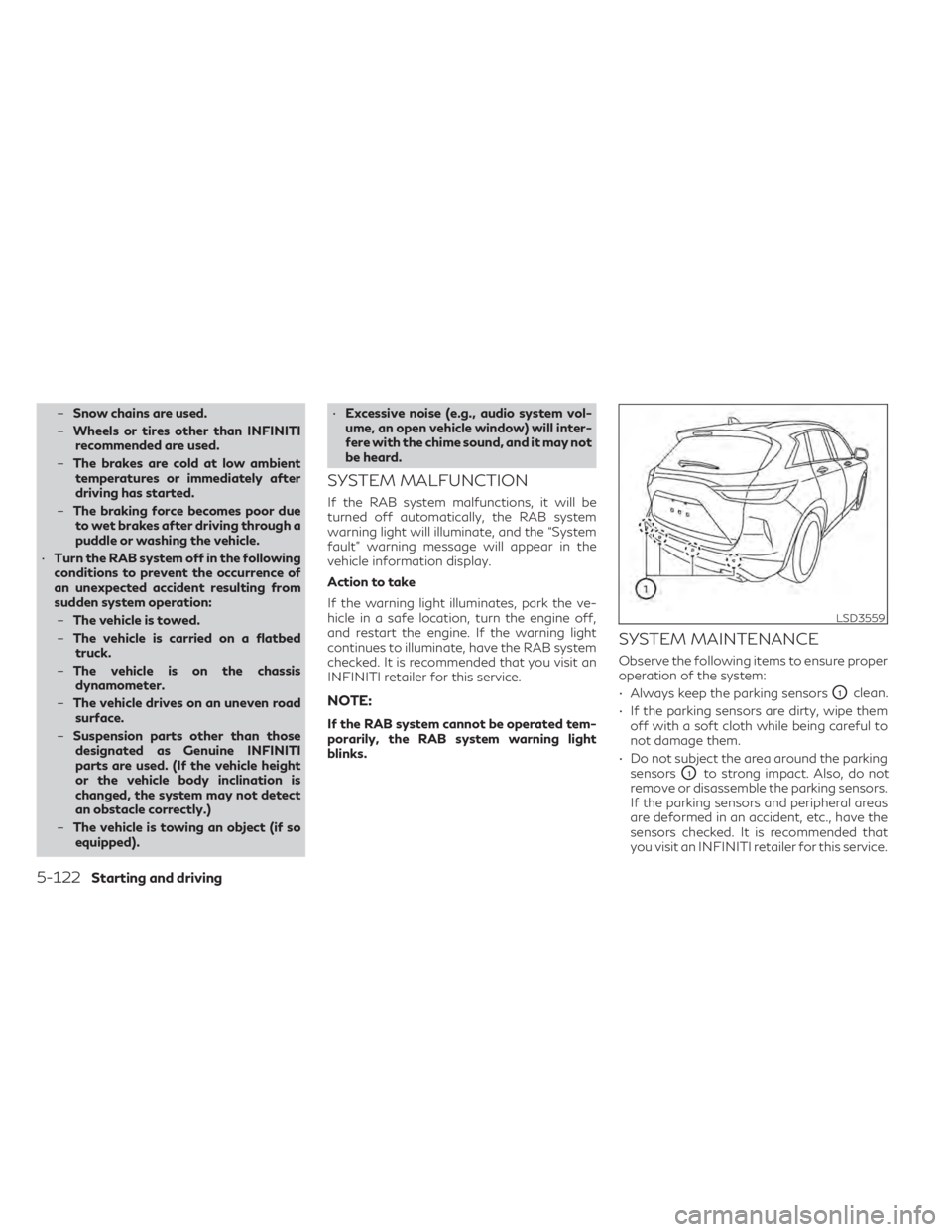
–Snow chains are used.
– Wheels or tires other than INFINITI
recommended are used.
– The brakes are cold at low ambient
temperatures or immediately after
driving has started.
– The braking force becomes poor due
to wet brakes after driving through a
puddle or washing the vehicle.
• Turn the RAB system off in the following
conditions to prevent the occurrence of
an unexpected accident resulting from
sudden system operation:
– The vehicle is towed.
– The vehicle is carried on a flatbed
truck.
– The vehicle is on the chassis
dynamometer.
– The vehicle drives on an uneven road
surface.
– Suspension parts other than those
designated as Genuine INFINITI
parts are used. (If the vehicle height
or the vehicle body inclination is
changed, the system may not detect
an obstacle correctly.)
– The vehicle is towing an object (if so
equipped). •
Excessive noise (e.g., audio system vol-
ume, an open vehicle window) will inter-
fere with the chime sound, and it may not
be heard.
SYSTEM MALFUNCTION
If the RAB system malfunctions, it will be
turned off automatically, the RAB system
warning light will illuminate, and the “System
fault” warning message will appear in the
vehicle information display.
Action to take
If the warning light illuminates, park the ve-
hicle in a safe location, turn the engine off,
and restart the engine. If the warning light
continues to illuminate, have the RAB system
checked. It is recommended that you visit an
INFINITI retailer for this service.
NOTE:
If the RAB system cannot be operated tem-
porarily, the RAB system warning light
blinks.
SYSTEM MAINTENANCE
Observe the following items to ensure proper
operation of the system:
• Always keep the parking sensors
O1clean.
• If the parking sensors are dirty, wipe them off with a soft cloth while being careful to
not damage them.
• Do not subject the area around the parking sensors
O1to strong impact. Also, do not
remove or disassemble the parking sensors.
If the parking sensors and peripheral areas
are deformed in an accident, etc., have the
sensors checked. It is recommended that
you visit an INFINITI retailer for this service.
LSD3559
5-122Starting and driving
Page 411 of 542

6 In case of emergency
Hazard warning flasher switch...................6-2
Roadside assistance program .....................6-2
Emergency engine shut off .......................6-3
Flat tire ..........................................6-3
Tire Pressure Monitoring System (TPMS) ......6-3
Run-flat tires .................................6-4 Jump starting
....................................6-5
Push starting ....................................6-7
If your vehicle overheats .........................6-7
Towing your vehicle ..............................6-8
Towing recommended by INFINITI ............6-8
Vehicle recovery (freeing a stuck vehicle) ......6-11
Page 418 of 542

6. After the engine cools down, check thecoolant level in the engine coolant reser-
voir tank with the engine running. Add
coolant to the engine coolant reservoir
tank if necessary. Have your vehicle re-
paired. It is recommended that you visit an
INFINITI retailer for this service. When towing your vehicle, all jurisdictions
and local regulations for towing must be fol-
lowed. Incorrect towing equipment could
damage your vehicle. Towing instructions are
available from an INFINITI retailer. Local ser-
vice operators are generally familiar with the
applicable laws and procedures for towing.
To assure proper towing and to prevent ac-
cidental damage to your vehicle, INFINITI
recommends having a service operator tow
your vehicle. It is advisable to have the service
operator carefully read the following
precautions:
WARNING
• Never ride in a vehicle that is being
towed.
• Never get under your vehicle after it has
been lifted by a tow truck.
CAUTION
• When towing, make sure that the trans-
mission, axles, steering system and pow-
ertrain are in working condition. Use dol-
lies or flatbed if any of the listed systems
are not working.
• Always attach safety chains before
towing. For additional information about towing your
vehicle behind a Recreational Vehicle (RV),
see “Flat towing for all-wheel drive vehicle”
(P. 10-28) or “Flat towing for front wheel
drive vehicle” (P. 10-29).
TOWING RECOMMENDED BY
INFINITI
INFINITI recommends towing your vehicle
based upon the type of drivetrain. For addi-
tional information, refer to the diagrams in
this section to ensure that your vehicle is
properly towed.
TOWING YOUR VEHICLE
6-8In case of emergency
Page 419 of 542

All-Wheel Drive (AWD) models with
Continuously Variable Transmission
(CVT)
INFINITI recommends that towing dollies be
used when towing your vehicle or place the
vehicle on a flatbed truck as illustrated.
CAUTION
Never tow AWD models equipped with a
Continuously Variable Transmission (CVT)
with any of the wheels on the ground as
this may cause serious and expensive dam-
age to the transfer case and transmission.
NOTE:
If the battery is completely drained the
transmission will not manually shift to other
positions.
LCE2370
In case of emergency6-9
Page 420 of 542

Two-Wheel Drive models with
Continuously Variable Transmission
(CVT)
INFINITI recommends that your vehicle be
towed with the driving (front) wheels off the
ground or place the vehicle on a flatbed truck
as illustrated.
NOTE:
If the electronic parking brake is released,
the rear wheels can be grounded while tow-
ing. If the electronic parking brake is not re-
leased, towing dollies should be used. For
additional information, see “Electronic
parking brake” (P. 5-23).
CAUTION
• Never tow Continuously Variable Trans-
mission (CVT) models with the front
wheels on the ground or four wheels on
the ground (forward or backward), as
this may cause serious and expensive
damage to the transmission. If it is nec-
essary to tow the vehicle with the rear
wheels raised always use towing dollies
under the front wheels.
• When towing Continuously Variable
Transmission (CVT) models with the rear
wheels on the ground or on towing
dollies:
– Place the ignition switch in the OFF
position, and secure the steering
wheel in a straight-ahead position
with a rope or similar device. Never
secure the steering wheel by placing
the ignition switch in the LOCK posi-
tion. This may damage the steering
lock mechanism (for models with a
steering lock mechanism).
NOTE:
If the battery is completely drained the
transmission will not manually shift to other
positions.
LCE2371
6-10In case of emergency
Page 421 of 542
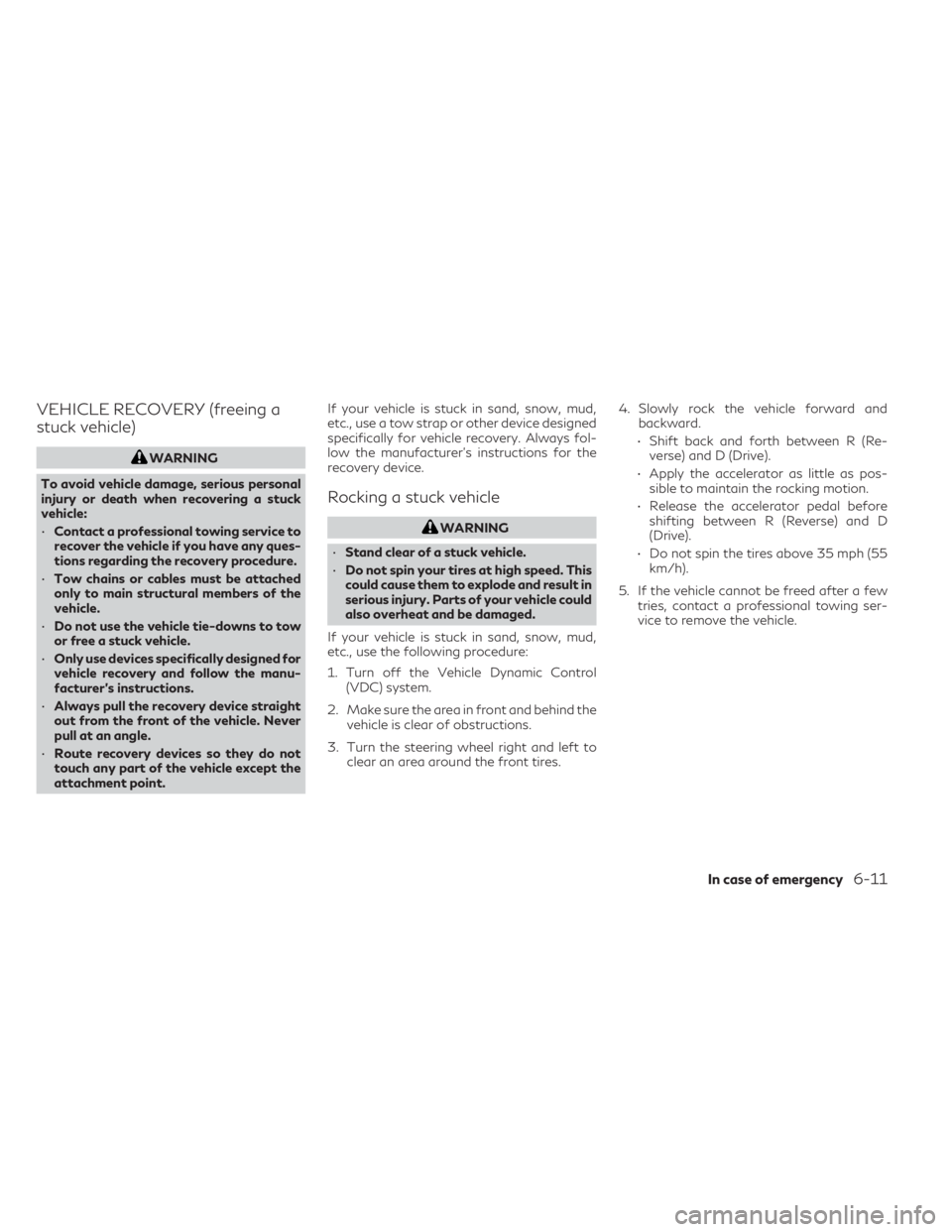
VEHICLE RECOVERY (freeing a
stuck vehicle)
WARNING
To avoid vehicle damage, serious personal
injury or death when recovering a stuck
vehicle:
• Contact a professional towing service to
recover the vehicle if you have any ques-
tions regarding the recovery procedure.
• Tow chains or cables must be attached
only to main structural members of the
vehicle.
• Do not use the vehicle tie-downs to tow
or free a stuck vehicle.
• Only use devices specifically designed for
vehicle recovery and follow the manu-
facturer's instructions.
• Always pull the recovery device straight
out from the front of the vehicle. Never
pull at an angle.
• Route recovery devices so they do not
touch any part of the vehicle except the
attachment point. If your vehicle is stuck in sand, snow, mud,
etc., use a tow strap or other device designed
specifically for vehicle recovery. Always fol-
low the manufacturer's instructions for the
recovery device.
Rocking a stuck vehicle
WARNING
• Stand clear of a stuck vehicle.
• Do not spin your tires at high speed. This
could cause them to explode and result in
serious injury. Parts of your vehicle could
also overheat and be damaged.
If your vehicle is stuck in sand, snow, mud,
etc., use the following procedure:
1. Turn off the Vehicle Dynamic Control (VDC) system.
2. Make sure the area in front and behind the vehicle is clear of obstructions.
3. Turn the steering wheel right and left to clear an area around the front tires. 4. Slowly rock the vehicle forward and
backward.
• Shift back and forth between R (Re- verse) and D (Drive).
• Apply the accelerator as little as pos- sible to maintain the rocking motion.
• Release the accelerator pedal before shifting between R (Reverse) and D
(Drive).
• Do not spin the tires above 35 mph (55 km/h).
5. If the vehicle cannot be freed after a few tries, contact a professional towing ser-
vice to remove the vehicle.
In case of emergency6-11